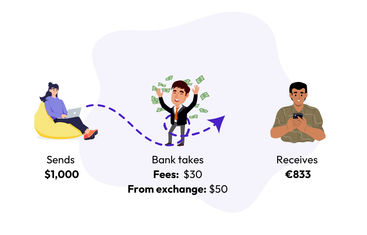Sending money using a bank account will cost around 5% more than using a money transfer company. It's possible to save thousands of dollars by not sending through a bank account.
Bank fees in action
Sending money through a bank will likely cost you upwards of 3%, but potentially in the region of 5-6%. This is because of bad exchange rates and fees which make sending money expensive. There may also be correspondent fees on top.
Receiving money into your bank account from a different currency is a bad idea. It will result in paying fees on the incoming transfer. These can be up to $30, or an equivalent. There's also an exchange rate on the money to be converted. This can be upwards of 1%, but usually sits within the 3-5% range.
Correspondent fees and intermediary fees, what are these?
One of the reasons banks give you a bad deal on international transfers lies within these fees.
Correspondent and intermediary fees play a part. These are fees charged for a bank to move money through a country to get it to the final destination. To do this they may use third party banks, who will take their cut for the work involved.
What is the interbank rate and is it included in fees?
Also known as the mid-market rate, the is rate banks by and sell currencies. The exchange rate is the markup third parties add when providing a service.
Totalling up the cost of using a bank

For sending
With higher rates and fees and correspondent bank fees, this is what a transfer can look like.
This is based on sending $1,000 to EUR. Percentages and differences will be similar in Canada, the UK, UAE or Australia as well.
For receiving
Imagine the same transfer, but for receiving the money into your account that HASN’T been converted. You receive less and pay more to your bank.
Moving money at lower cost
For sending
Sending abroad without large bank fees is easy. Use a money transfer company.
Wise offers transfers at fees of 0.33%, but at the mid-market rate. So much cheaper than using a bank.
.png)
For receiving
Using a local account will allow you to reduce the cost of receiving money sent in a different currency.
What does each bank charge?
Bank Name | Exchange rate | Sending fees | Receiving fees |
|---|---|---|---|
Chase Bank | 2% to 7% | $40-50 | $0-15 |
Bank of America | 5.3% to 7.37% | $45 | $16 |
Navy Federal Credit Union | 3% to 5% | $25 | $0 |
Wells Fargo | 6% | $25-50 | $15 |
Citigroup | 4% to 6% | Up to $35 | $15 |
Bank Name | Exchange rate | Sending fees | Receiving fees |
|---|---|---|---|
NatWest | 0.58% to 2.54% | Sliding scale | £7 (£0 for Euro) |
HSBC | 1.01% to 3.51% | Sliding scale | £5 (£0 for Euro) |
Lloyds | 2.1% to 3.56% | Sliding scale | £7 (£0 for Euro) |
Nationwide | 2.20% | Fixed margin | £0 |
Barclays | Up to 2.75% | £25 | £6 (£0 for Euro) |
Bank Name | Exchange rate | Sending fees | Receiving fees |
|---|---|---|---|
First Abu Dhabi Bank | Averages around 4.5% | 100 AED | |
Emirates NBD | Up to 4.6% | 60 AED + 1.99% | 105 AED |
Mashreq Bank | 1.5% to 6% | 25 AED | 2.89% |
RAKBANK | 2.30% | 50 AED | 0 AED |
Dubai Islamic Bank | 2.50% | 52.50 AED | 10.50 AED |
Bank Name | Exchange rate | Sending fees | Receiving fees |
|---|---|---|---|
RBC | 2.7% to 4.4% | 0 CAD | 17 CAD |
TD Bank | 2.31% to 5.14% | 50 CAD | 15 CAD |
Scotia Bank | 3.35% | 1.99 CAD | 15 to 17 CAD |
Bank of Montreal | 2.85% to 3.8% | 15 CAD to 125 CAD / 0.2% | 16 CAD |
CIB | 2.5% to 3.5% | No fees | 30 CAD - 80 CAD |
Bank Name | Exchange rate | Sending fees | Receiving fees |
|---|---|---|---|
NAB | from 3% | 30 AUD | 30 AUD |
Westpac | 4.50% | No fees | 12 AUD |
Commonwealth Bank | 4.25% | 6 AUD | 35 AUD |
ANZ | 1.80% | from 5 AUD | 15 AUD |
BOQ | 4% to 4.5% | 1% (minimum 5 AUD) | 15 AUD |
Is PayPal any better? 🤔
No. PayPal is not suitable for sending abroad.
Here’s how their fees stack up as well:
Country | Exchange rate | Sending fees | Receiving fees |
|---|---|---|---|
USA | 3.50% | 5% (max. $4.99) | 1% |
UK | 3% to 4% | 5% (max. £4.99) | 1% |
UAE | 4.50% | 3.49% (max. 36.70 AED) | 1% |
Canada | 3.50% | 5% (max. 4.99 CAD) | 1% |
Australia | 5% | 3.49% (max. 5.99 AUD) | 1% |
Getting the best rate for a transfer
Using a money transfer company based on the amount you want to send abroad is the best way. This will beat the cost of using a bank, but also allow you to compare cheaper options, and get the best deal overall.
Do not use PayPal or banks unless you are making a domestic transfer. It will eat into the money and the time it takes to send the money will likely be longer.
